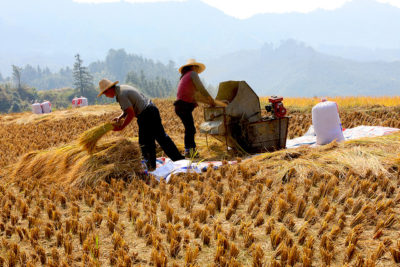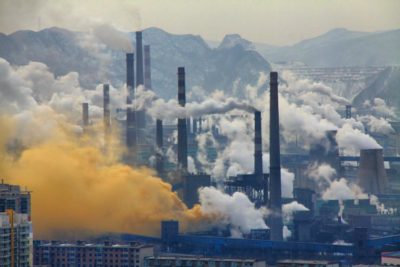China in the Global Environment — Q&A with Isabel Hilton, Founder and CEO of chinadialogue.net

Isabel Hilton is a leading journalist whose current work spotlights the impact of China’s growing economy on people and the environment. Her work has appeared in the Financial Times, The New York Times, the Los Angeles Times, The Guardian, the New Yorker, and many other publications. In 2006, Hilton launched chinadialogue.net, a groundbreaking website that publishes reporting and analysis on China environment issues in both English and Mandarin.
This month, Hilton spoke with students, faculty, and the public at UCLA Law on the implications of China’s Belt and Road Initiative for climate change. Hilton wrote about these issues in a recent essay for Yale Environment 360. I sat down with Hilton to talk about some of China’s overlooked environmental problems. The conversation below has been edited for length and clarity.
Beyond chinadialogue.net, you now have a network of websites focused on different issues. Tell us about these sites.
We started chinadialogue.net in 2006 and since then we’ve launched several other websites: The Third Pole investigates transboundary water issues in the Himalayan watershed, which provides irrigation, water, and power to more than a billion people. India Climate Dialogue is dedicated to covering climate issues in India. Dialogo China looks at the China-Latin America relationship, and our oceans website covers the impacts of China as an ocean power, with its seafood industries, its huge fishing fleet and plastic pollution problem.
China’s been getting the most attention on air pollution and climate. Chinadialogue.net has a much broader focus. What are the big issues with China and the environment that you think people have not paid enough attention to?
I’m not sure that people who look at China understand the gravity of the water situation.
Water in China suffers from multiple stresses. China doesn’t start off with a generous allocation of freshwater, given the weight of its population. It’s already quite water stressed as a country. Most of the water is south of the Yangtze River, and a lot of the population (and GDP) is north of the Yangtze River.
It got to the point where some years ago, the Yellow River, the mother river of China, dried up, and didn’t reach the sea. This was a tremendous shock. And it was a symptom of a serious problem with multiple factors: over-extraction, destruction of headwaters, pollution, uncontrolled discharge into water bodies, and extraction of groundwater.
There isn’t an easy remedy. China’s surface water was so badly contaminated that at one point 20 percent of China’s surface water was grade 5, which you shouldn’t even go near [Editor’s note: China grades its water quality on a 1-5 scale, with 1 being good and 5 being hazardous]. Not only was water scarce, it was badly managed and badly polluted.
The Chinese have a long tradition of engineering – and tend to think that engineering fixes these things. So one of the solutions proposed, was the South-North Water Project, to transfer water from the water-rich south of China to the north. It was hugely expensive, and actually not a solution. One leg of the project is nominally in operation, and delivers an inadequate amount of not very clean water to the north.
China’s water issues could get worse. With climate change, the monsoon begins to vary, you tend to get more intense rain over a shorter time and you lose more of the rain that falls. Damming the rivers has altered the availability of water. Water is so essential – to life, to business, to the good functioning of society. It’s a big problem for China that doesn’t get a lot of attention outside the country.
The second issue that we found pretty intractable and difficult, was soil pollution.
Guangdong province was one of the early industrializing provinces, with a special industrialized zone and investment from Hong Kong. A lot of early factories of all kinds had flourished there. Some of our journalists went down to look at health impacts including from soil pollution in Dongguan, a town in Guangdong Province, and they met the most enormous resistance.
There had been a provincial report, which said that 27 percent of the soil had been polluted with heavy metals. But nobody would tell us where that soil was. It might be in a market garden, or under a factory. If you didn’t know that, nothing was being done.

About three years ago, we had another go, with a series on soil pollution. Again, it was very hard going. By then, there had been a nationwide survey of soil pollution but it was still being treated like a state secret. You had enormous pockets of toxic legacies, often from small factories that had gone bust or moved and left behind these terrible sites, leaching into surrounding farmlands where crops were still being grown.
In Hunan, an important rice-growing region, the provincial authorities wouldn’t test the rice. But if the rice went to Guangzhou, it would be tested and found to be contaminated.
Soil pollution is one of the most expensive and intractable problems for China. A recent story was about a school built on a toxic site, where 500 students became sick.
China is increasingly going out into the world. How have you covered this process?
An overarching theme for us in recent years has been the Belt and Road Initiative. The aim of the project is to create industrial economies in partner countries, all connected to China.
But countries that are part of the Belt and Road Initiative do not necessarily have strong environmental protections or robust rule of law. Countries that join also face the risk of debt, as Chinese companies can gain an advantage financing projects that don’t recover their costs.
Another important issue for Belt and Road is the role of coal. I have been dismayed at the lock-in of coal use. Countries that build new coal plants today risk creating stranded assets, with all the associated debts. If they keep operating the plants, they risk exceeding carbon budgets.
What’s to be done?
Developed countries should do more. The EU and the U.K. have both been quite ambitious, as well as California, of course. But there is a concern for what happens if emerging economies adopt the Chinese model of development.

The energy transition is eminently possible. And China has played an important role in bringing down the cost of renewable energy through its tremendous manufacturing capacity, which in most places has brought the cost of new renewable energy below the cost of new coal and in some cases, gas. So doing the right thing by the climate should no longer involved economic sacrifice.
The argument that “coal is cheap” is really not true. If we took the environmental damage into account it never was, but now it is an expensive option even without the externalities.
Those who do build coal plants face a choice: do I continue to operate and emit more carbon than is safe, or do I close down before the plant has paid for itself? These coal plants are also being built in countries with the least capacity to adapt to climate change – and pay for a transition to clean energy.
It’s important to call China out on its coal investments abroad. There’s a real conflict between China’s commitment to eco-civilization at home and to the UNFCCC process – and its funding for coal. China’s leaders know the dangers – and they know the transition needs to come.
Why not use the Belt and Road Initiative as a flagship endeavor [for sustainable development]?
But one problem is that big Chinese enterprises are subverting the state’s policies which aim to foster sustainable, environment and climate friendly growth, along with developing a circular economy. Building new coal undercuts all that, but it seems that the Chinese state can’t or won’t control them.
Chinese development banks finance many coal projects overseas and standards for environmental protection are unclear. Can you tell us more about their role?
Yes, these are China’s policy banks, but they operate in an opaque way. Latin America, for example, has a lively civil society, with effective opposition to new industrial projects, but groups there have had trouble gaining purchase against China’s development banks. They’ve had no response to requests for information. These banks operate in an opaque, unaccountable way, with hidden contracts. And the banks operate with the power of the Chinese state behind them.
It’s all very well to set up the Asia Infrastructure Investment Bank, but these other Chinese banks make much bigger investments. It’s within China’s power to control these banks. It’s within the power of the state.
Do you see India’s pathway to development as being similar to or different from China’s?
We used to hear the “you broke it, you fix it” line from India’s policymakers on climate change, arguing that developed countries should take responsibility for reducing greenhouse gas emissions, rather than India. That is beginning to change. In India, there is a big solar mission which will build new networks of renewable energy. It’s a better option for villages to generate electricity.
The climate issue – both the impacts and the international conversation – has also arrived in India at an earlier stage in its development than in China.
We’ve focused on bad news for much of today. What makes you optimistic on climate change?
When you look at the cold facts on climate change, it’s quite hard. But before the UNFCCC process kicked in, we were seeing estimates of 8°C of warming. That’s been brought down to around 3.5°C with current pledges and despite the US notice of withdrawal, the Paris Agreement process has not collapsed.
We’re also seeing technology growing by leaps and bounds. I’m not a technological utopian, but the problems we’re concerned about now are different from ten years ago, when, for example, we weren’t sure if we could solve the intermittency of renewable energy. In Britain, we have had several recent days where the grid has run without coal. Renewable energy has developed much faster than predictions for the technology anticipated. The market understands the potential.
China decided to stop accepting imports of plastic waste in 2018, which has forced both the federal and local governments here in the U.S. to confront the problem. Can you give us a sense of the Chinese perspective on this issue?
China’s decision to not take any more plastic has been healthy for both sides. When individuals and the U.S. and U.K. could just recycle their bottles and containers, there was no pressure. We could just use and discard.
But a lot of the plastic waste going to China was contaminated, so it would be either dumped or incinerated. The plastic waste imports also had a big effect on Chinese people in the supply chain. A documentary, Plastic China, brought attention to these issues. It’s an extraordinary film about a family in the plastics industry, showing their conditions and lives. Eventually the movie was banned, like the one on air pollution [Under the Dome (2015)]. But the film forced change.
China adopted a law against single-use plastic bags. This made a difference, but it’s been overtaken by the growth in online shopping, which is filled with plastic wrapping.
The bigger picture is that China has a lack of effective solid waste management. A lot of waste ends up in rivers and oceans, and there’s local resistance to incineration.
To solve the issue, we need to go to the origin. Right now, it’s too cheap to discard plastic. We need to make it more expensive – a polluter pays model. And we need more investment in recycling, both in mechanical recycling, which can re-purpose plastics a limited number of times, and in chemical recycling, which can go on forever, but is an industrial process which requires more infrastructure.
Thank you for taking the time to talk with us.






Reader Comments